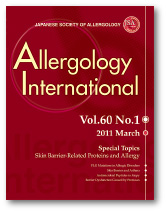Toshiko Takeda
(AI editorial staff, Japanese Society of Allergology)

Allergology International (AI), of which I am a member of editorial staff, is the only clinical medicine journal designated as a SPARC Japan partner journal.
● Outline of the JSA
To begin with, I would like to briefly introduce the Japanese Society of Allergology (JSA). Our members are composed of medical researchers and clinicians whose theme of research or practice is allergies and clinical immunology. According to their specialties, clinicians can be divided into internal medicine physicians, pediatricians, otolaryngologists, dermatologists, and ophthalmologists. Reflecting an explosive increase in the number of allergy sufferers such as those allergic to cedar pollen over the past 20 to 30 years, the number of JSA members has increased to above 10,000. As a prominent example of its recent activities, the JSA sought to provide accurate information to patients, medical practitioners, and the general public on skin allergies and wheat allergies caused by Cha no Shizuku soap, a case that developed into a social issue.
● Changes in the AI after Participation in SPARC Japan
It was in 2004 that the AI was designated as a SPARC Japan partner journal. Following that, the AI has undergone significant changes and development.
In 2005, we terminated the contract with the overseas commercial publisher, through which the AI had been published since 1996, and started publishing the journal on our own. Around the same time, we established our own server as a platform for online journals and it was determined that the journals should be made open access. The AI was listed in the MEDLINE database in 2006 and the number of citations has since increased steadily. In 2012, it was determined that the AI would be listed in the Web of Science as well. The impact factor (IF) of the AI will be announced in 2015, which would mean reaching our long-sought milestone. As such, it is fair to say that participation in the SPARC Japan prompted a shift to the self-dependent management of journals.
In fact, since 2000 or four years after its launch, the AI had been caught up in a vicious cycle in which a decrease in the number of submissions caused a decline in the visibility of the journal, further decreasing the number of submissions. At the time, the publication of the AI was entirely entrusted to a major overseas publisher having extensive experience in publishing medical journals and we kept to waiting for suggestions from the publisher regarding ways to raise the visibility of our journal. This, however, turned out to be one-way expectations.
Currently, Kyorinsha is helping us with the printing of the AI as well as with the development and operation of our server. Furthermore, we have been able to develop an archive of the back number of our online journals (covering the period 1994-2004) thanks to SPARC Japan’s support program.
In the field of allergy research, the Journal of Allergy and Clinical Immunology (U.S.) and the Allergy (Germany) are always cited as the world’s top ranking journals in terms of IF. Meanwhile, the Korean Academy of Asthma, Allergy and Clinical Immunology and the Korean Academy of Pediatric Allergy and Respiratory Disease launched the Allergy, Asthma & Immunology Research in 2009 and it was announced in 2011 that its IF was 1.91. Research on allergic diseases is also being conducted vigorously in Southeast Asia and the Middle East. Indeed, about 20 journals are competing in the world.
● Participation in SPARC Japan Seminars
SPARC Japan seminars typically include lectures discussing practical problems faced by editorial staff of Japanese scholarly journals, presentations on innovative initiatives being implemented overseas, and sessions designed to explore future directions. I always look forward to attending SPARC Japan seminars because I can see the ingenuity and enthusiasm of organizers in the excellent selection of topics and lecturers (for instance, an urgent symposium was held on October 19, 2004 under the title of “How should Japanese Scholarly Journals Respond?”). More recently, SPARC Japan seminars are also serving as an important forum not only for editorial staff of scholarly journals but also for researchers, librarians, overseas publishers, and those from related relevant business industries such as printing to discuss issues surrounding scholarly journals from their respective points of view. Those of us who are engaged in the editing of scholarly journals are often working alone in their respective workplace and the presence of opportunities to share various problems with our cohorts from diverse viewpoints, such as those provided by SPARC Japan seminars, is very encouraging.
Lastly, let me note that Professor Hirohisa Saito, editor-in-chief of the Allergology International and deputy director of the National Research Institute for Child Health and Development, led the change of the AI discussed above.
|

